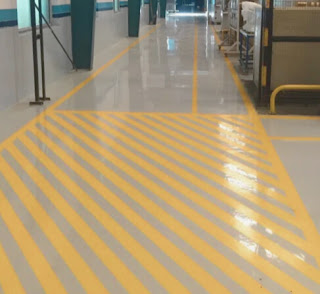How to Choose the Right Epoxy Finish for Residential Interiors
When it comes to giving your home a modern, durable, and stylish flooring upgrade, epoxy flooring has become a popular option among homeowners. What was once considered an industrial or commercial flooring solution has now made its way into living rooms, kitchens, basements, and even bedrooms. But not all epoxy floor covering options are the same. Choosing the right one for your residential interior depends on a variety of factors—functionality, design preferences, lifestyle, and budget.
Epoxy flooring services go beyond just applying a shiny coating; they involve transforming dull concrete surfaces into strong, elegant, and low-maintenance floors. Known for their resistance to stains, water, and abrasions, epoxy floors can handle the wear and tear of everyday life. That said, the type of finish you choose will significantly impact the overall look and feel of your home. So, before diving into color charts and textures, it’s important to understand what options are available and how they align with your household needs.
Start with the Purpose of the Room
Each room in your house serves a different purpose, and the flooring needs to match its function. For example, a high-gloss epoxy finish might be stunning in the living room but could be slippery and impractical in a kitchen or bathroom where spills are common. In contrast, a matte or textured finish might be a better fit for those high-moisture or high-traffic areas.
If you’re considering epoxy flooring for your garage-turned-game-room or a basement gym, go for a more rugged and slip-resistant finish. For living spaces or bedrooms, you can opt for a smoother, more decorative finish that complements your interior design style.
Consider Your Design Aesthetic
One of the biggest advantages of epoxy flooring is its versatility in design. It’s no longer just a grey industrial floor—today’s finishes can mimic marble, granite, or even terrazzo. If you love a minimalist and clean look, a solid color finish in neutral tones might be ideal. For those who prefer bold interiors, metallic finishes can create a swirling, three-dimensional effect that becomes a focal point of the room.
Another trend that’s gaining popularity in epoxy flooring services for homes is the use of flake systems. These are made by scattering decorative vinyl flakes over the base coat, adding texture, color, and grip. Flake floors are excellent for family rooms, playrooms, or anywhere kids and pets are likely to run around.
Think About Lighting and Room Size
Epoxy flooring can affect the perception of space and light in your home. Glossy finishes reflect more light and can make a smaller room feel bigger and brighter. This is great for spaces like hallways, narrow kitchens, or compact living rooms. On the other hand, if you already have a lot of natural light, a high-gloss finish might create too much glare. In such cases, satin or matte finishes offer a balanced and elegant look without being overly reflective.
Color choice also plays a role in how large or cozy a room feels. Light-colored epoxy floor covering, such as pale grey or beige, can open up a space, while darker tones provide a more intimate and grounded ambiance.
Maintenance Expectations
While all epoxy flooring services are relatively low-maintenance compared to hardwood or tile, some finishes require more upkeep than others. High-gloss finishes may show dust, smudges, or scratches more easily. If your household includes kids, pets, or high foot traffic, you might want to go for a more forgiving matte or semi-gloss finish that hides imperfections better.
Also, consider whether you’ll need slip-resistant additives in rooms prone to moisture, like bathrooms, laundry rooms, or entryways. These can be added during the application process and will make daily use safer without compromising the appearance too much.
For patios or balconies, consider a specialized outdoor epoxy floor. These are designed to withstand UV exposure and weather conditions while maintaining a consistent finish.
Longevity and Durability
Epoxy flooring is known for its longevity, but the durability of your finish depends on the quality of the materials and the installation. In residential interiors, you won’t face the same level of abuse as in industrial spaces, but it’s still smart to choose a finish that can hold up over time.
If you expect heavy furniture, frequent movement, or the occasional dropped object, consider a finish that includes multiple topcoats for extra protection. Decorative finishes with flakes or quartz aggregates not only add style but also reinforce the surface. Investing a little more upfront can save you the headache of repairs or re-coating down the line.
Professional vs. DIY Application
While epoxy kits are available in hardware stores and online, applying an epoxy finish is more complex than it looks. A poor application can lead to bubbles, uneven coating, or peeling within a few months. For interiors where appearance matters just as much as performance, hiring a professional installer is often the smarter route. Professionals can help you choose the right formulation, prepare the concrete surface properly, and apply the finish evenly.
If you’re in Karnataka, working with epoxy flooring contractors in Bangalore ensures you get local expertise tailored to the climate and common residential needs in the region. Reputable contractors in the city also tend to offer a variety of finish options, from decorative flake to high-gloss metallic, suited for different rooms and budgets.
Budget and Value
Your budget will naturally influence your choice, but epoxy flooring remains one of the more cost-effective options for residential spaces when you consider its lifespan and low maintenance needs. Simple, single-color finishes are the most affordable, while decorative systems like metallic or quartz finishes cost more due to added materials and labor.
It’s essential to look beyond the initial cost and think about long-term value. A well-installed epoxy floor covering can last 10 to 15 years or more with minimal upkeep, saving you money on future repairs or replacements.




Comments
Post a Comment